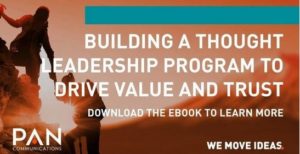Introducing PaymentsSource Senior Editor, Kate Fitzgerald

Do you remember having to drive to the store, shop, and then pull out your checkbook to pay for groceries when you didn’t have cash or credit card? I do. But now, I sit on my couch, click for the groceries I want and pay in-app on my smartphone. The way we transact online has been revolutionized, providing convenience to how we conduct our day-to-day tasks like grocery-shopping. This is why a number of fintech startups have emerged around payment technologies – there’s a huge market opportunity to tap into with new innovations.
In light of the rapid changes and shifts happening in this industry, there’s a few trade media specifically focused on payment news, trends and brands, including PaymentsSource. One reporter I’ve begun working with, as my clients sit tangentially in this space, is Kate Fitzgerald, a senior editor at the publication.
 See our conversation below to learn more about Kate, PaymentsSource and the stories that excite her each day:
See our conversation below to learn more about Kate, PaymentsSource and the stories that excite her each day:
Tell us a little about yourself.
I’ve been a journalist for many years, starting at newspapers and moving to business magazines, now working for PaymentsSource, a publication that is 100% digital. I started with typewriters and mainframe computers, moved to PCs and now I can write and edit on my phone (in combination with two PCs and an iPad mini—I use all of them at once!). I use Voice Memos and Noteability to capture quotes in person and during conference presentations.
What stories, trends or issues are on your radar today?
Lately I’ve been writing a lot about how U.S. banks and merchants are catching up with the rest of the world in the move to contactless (tap to pay) cards. Other big themes for me are new approaches to blocking fraud, expanding digital payment technology to far-flung new markets, removing the friction and cost of cross-border remittances, and the role women are starting to play in driving payments technology innovation.
Overall, we cover the technical end of payments and how evolving technology is disrupting things openly and behind the scenes for businesses, consumers, banks, merchants and other incumbents.
Over the last few years – what have you seen that were the biggest moments of opportunity?
Being the first to try a new technology is often a bold and newsworthy opportunity for companies. Financial services has always been a very cautious industry, because of the high standard for accuracy and security required. But increasingly all organizations are being forced to take more strategic risks. Banks are realizing that trying something new and failing is sometimes better than sitting on the sidelines in this fast-changing digital environment. We want to go on those journeys with companies and document what works, what lessons are being learned and who the innovators are.
Are you noticing any trends and specifics in how brands are digitizing?
Digitization sounds cold, but it’s actually giving all kinds of businesses the opportunity to reimagine existing processes as they should have been all along. No longer hobbled by time-consuming, manual steps that often involved paper or slow response times, digital approaches typically are exponentially more secure, and at the same time they can appear to be live, organic and spontaneous. When designing and marketing these new digital approaches, companies can bring a new kind of warmth and humanity to some operations that was never possible before.
How have today’s consumers/buyers changed the way brands do business?
The more the customer experience improves, the more customers demand a clean, convenient, fast approach to everything. It’s a tough standard to meet, especially with systems whose natures resist radical change.
Traditional banks once feared the approach of fintechs seemingly intent on “stealing” their most coveted assets—their customers and their data. But as we approach 2020, many legacy organizations are realizing they’re still in the driver’s seat, as long as they find intelligent ways to partner with fintechs and third parties to continue their own evolutions.
What is your dream assignment?
My dream assignment right now would be going to India, China or Africa to get a firsthand look at some of the emerging payment technologies we write about, in the big cities and the rural areas of these vast, expanding markets.
What advice do you have for PR folks who want to pitch you?
The telephone could be the most underrated tool in PR today. Some of the most interesting stories have come my way over the phone in the last couple of years. Be sure that if you’re making that call, you’re ready with your story pitch. Jump right in and give me the introduction.
Also, I love LinkedIn. I use it daily to cross-check and gather more background on the people and companies I’m writing about—though I check directly with sources to make sure biographical data is up to date. I read LinkedIn for links to interesting stories in my niche. Almost all my stories are posted on my LinkedIn profile and sometimes sources and readers comment, which could lead to a follow-up story if I discover a new fact or source in that discussion. I also post my stories to my Twitter account.
LinkedIn can also be a great way to reach a source on deadline when other channels fail. It’s a very useful channel for me that hasn’t been gummed up with irrelevant promotional announcements and queries from fraudsters.
